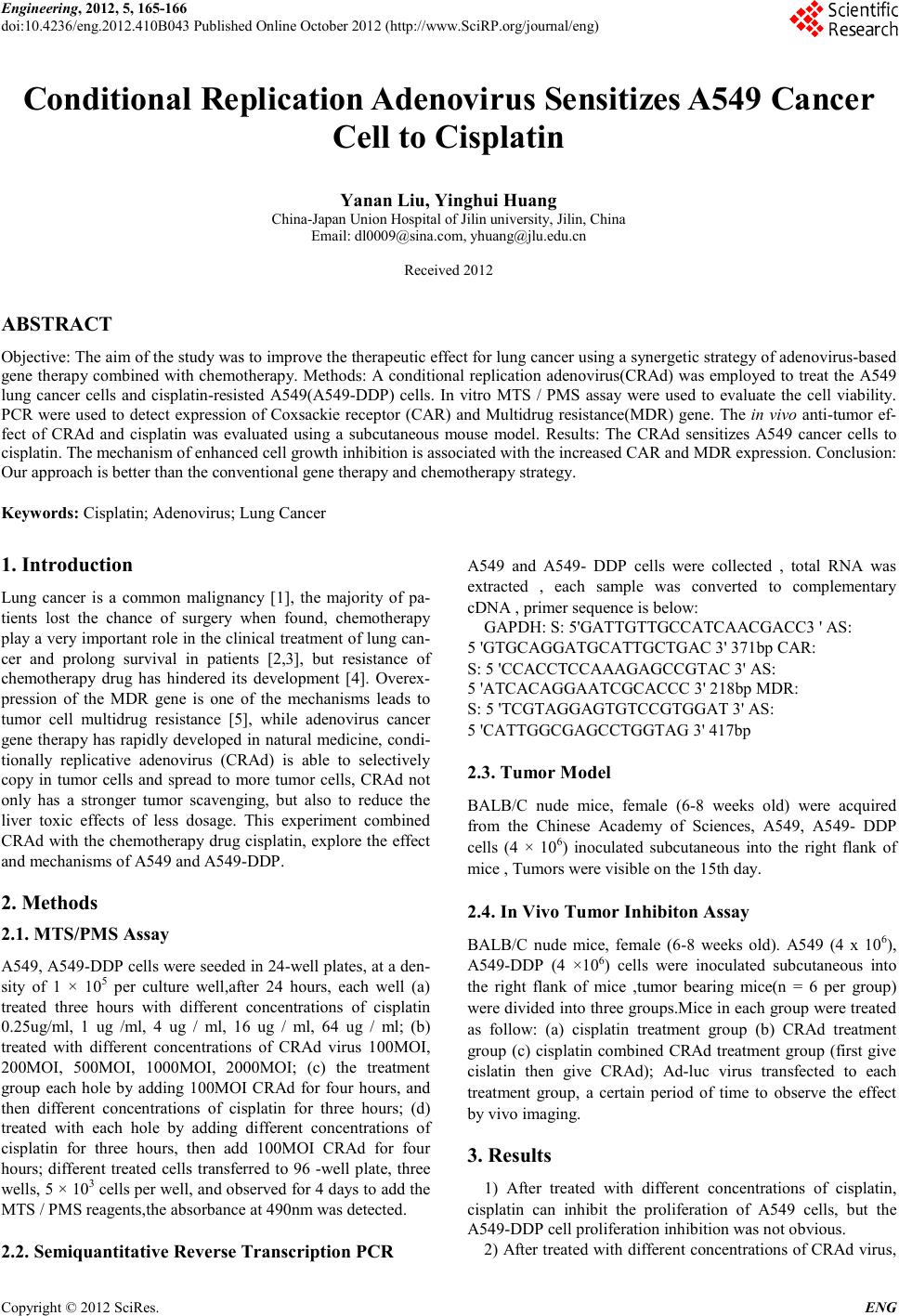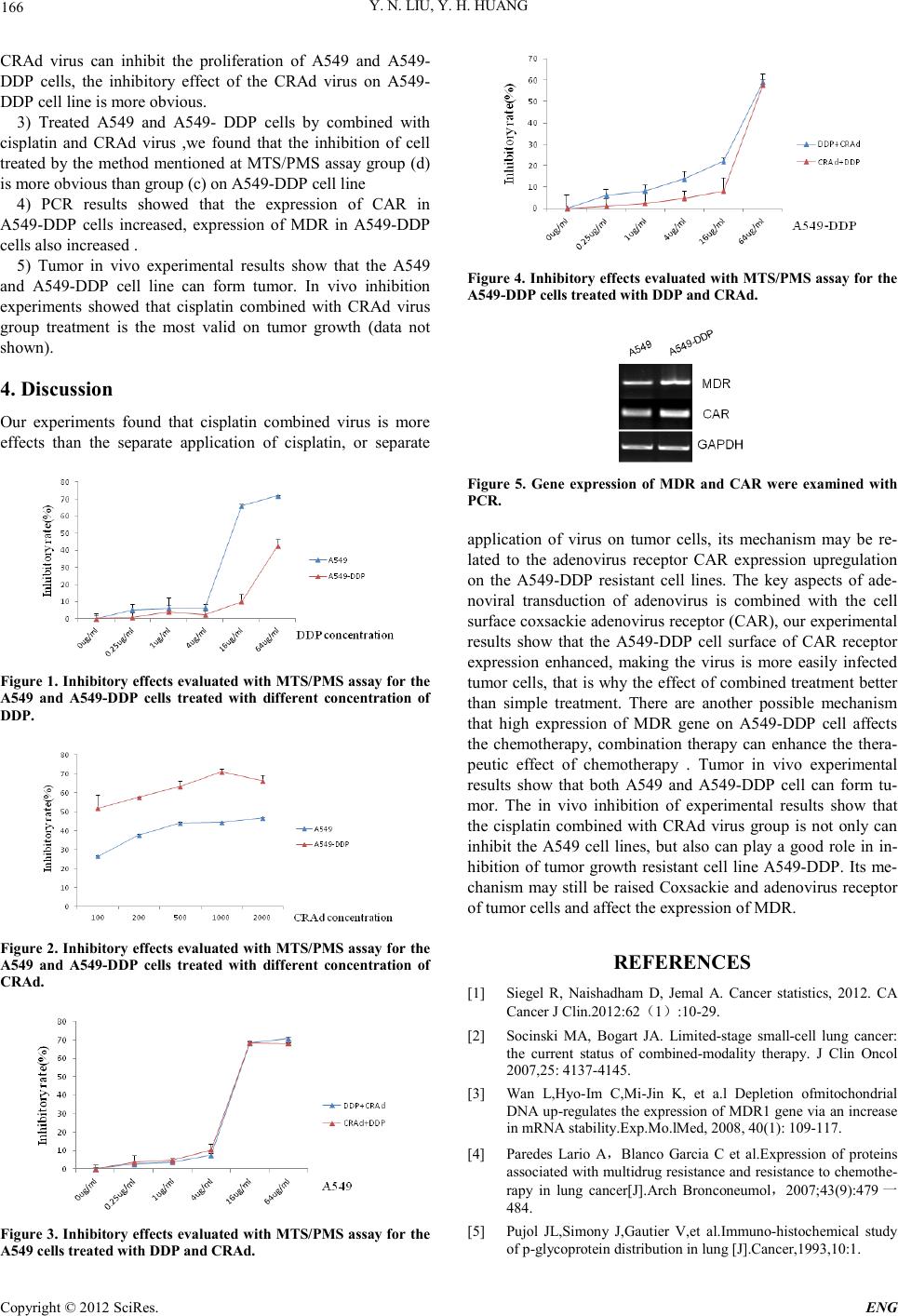Paper Menu >>
Journal Menu >>
 Engineering, 2012, 5, 165-166 doi:10.4236/eng.2012.410B043 Published Online October 2012 (http://www.SciRP.org/journal/eng) Copyright © 2012 SciRes. ENG Conditional Replication Adenovirus Sensitizes A549 Cancer Cell to Cisplatin Yanan Liu, Yinghui Huang China-Japan Union Hospital of Jilin university, Jilin, China Email: dl0009@sina.com, yhuang@jlu.edu.cn Received 2012 ABSTRACT Objective: The aim of the study was to improve the therapeutic effect for lung cancer using a synerget ic str ateg y of aden ovi ru s-based gene therapy co mbined with che motherap y. Methods: A conditional replication adenovirus(CRAd) was employed to treat the A549 lung cancer cells and cisplatin-resisted A549(A549-DDP) cells. In vitro MTS / PMS assay were used to evaluate the cell viability. PCR were used to detect expression of Coxsackie rec eptor (CAR ) and Multidrug resistance(MDR) gene. The in vivo anti-tumor ef- fect of CRAd and cisplatin was evaluated using a subcutaneous mouse model. Results: The CRAd sensitizes A549 cancer cells to cisplatin. The mechanism of enhanced cell growth inhibition is associated with the increased CAR and MDR expression. Conclusion: Our approach is better than the conventional gene th er apy and chemother apy strategy. Keywords: Cisplatin; Adenovirus; Lung Cancer 1. Introduction Lung cancer is a common malignancy [1], the majority of pa- tients lost the chance of surgery when found, chemotherapy play a ver y importan t role in the clin ical treatmen t of lung can- cer and prolong survival in patients [2,3], but resistance of chemotherapy drug has hindered its development [4]. Overex- pression of the MDR gene is one of the mechanisms leads to tumor cell multidrug resistance [5], while adenovirus cancer gene therapy has rapidly developed in natural medicine, condi- tionally replicative adenovirus (CRAd) is able to selectively copy in tumor cells and spread to more tumor cells, CRAd not only has a stronger tumor scavenging, but also to reduce the liver toxic effects of less dosage. This experiment combined CRAd with the chemotherapy drug cisplatin, explore the effect and mechanisms of A549 and A549-DDP . 2. Methods 2.1. MTS/PMS Assa y A549, A549-DDP cell s were seeded in 24-well plates, at a den- sity of 1 × 105 per culture well,after 24 hours, each well (a) treated three hours with different concentrations of cisplatin 0.25ug/ml, 1 ug /ml, 4 ug / ml, 16 ug / ml, 64 ug / ml; (b) treated with different concentrations of CRAd virus 100MOI, 200MOI, 500MOI, 1000MOI, 2000MOI; (c) the treatment group each hole by adding 100MOI CRAd for four hours, and then different concentrations of cisplatin for three hours; (d) treated with each hole by adding different concentrations of cisplatin for three hours, then add 100MOI CRAd for four hours; different treated cells transferred to 96 -well plate, three wells, 5 × 10 3 cells per well, an d observed for 4 days to add the MTS / PMS reagents,t he absorbance at 490nm was detected. 2.2. Semiquantitative Reve r se Tr anscriptio n PCR A549 and A549- DDP cells were collected , total RNA was extracted , each sample was converted to complementary cDNA , pr imer sequence is below: GAPDH: S: 5 'GATTGTTGCC ATCAACGACC3 ' AS : 5 'GTGCAGGATGC ATTGCTGAC 3' 371bp CAR: S: 5 'CCACCTCCAAAGAGCCGTAC 3' AS: 5 'ATCACAGGAATCGCACCC 3' 218bp MDR: S: 5 'TC GTA GGAGT GT C CGTGGAT 3' AS : 5 'CATTGGCGAGCCTGGT AG 3' 417bp 2.3. Tumor Model BALB/C nude mice, female (6-8 weeks old) were acquired from the Chinese Academy of Sciences, A549, A549- DDP cells (4 × 106) inoculated subcutaneous into the right flank of mice , Tumors were visible on the 15th day. 2.4. In Vivo Tumor Inhibiton Assay BALB/C nude mice, female (6-8 weeks old). A549 (4 x 106), A549-DDP (4 ×106) cells were inoculated subcutaneous into the right flank of mice ,tumor bearing mice(n = 6 per group) were divid ed in to thr ee group s.Mice in each group were treated as follow: (a) cisplatin treatment group (b) CRAd treatment group (c) cisplatin combined CRAd treatment group (first give cislatin then give CRAd); Ad-luc virus transfected to each treatment group, a certain period of time to observe the effect by vivo imaging. 3. Results 1) After treated with different concentrations of cisplatin, cisplatin can inhibit the proliferation of A549 cells, but the A549-DDP cell proliferation inhibition was not obvious. 2) After treat ed with d ifferent concen trations o f CRAd virus,  Y. N. LIU, Y. H. HUANG Copyright © 2012 SciRes. ENG 166 CRAd virus can inhibit the proliferation of A549 and A549- DDP cells, the inhibitory effect of the CRAd virus on A549- DDP cell line is more obvious. 3) Treated A549 and A54 9- DDP cells by combined with cisplatin and CRAd virus ,we found th a t the inhibition of cell treated b y the method mention ed at MTS/PMS assay group (d) is more obvious than group (c) on A549-DDP cell line 4) PCR results showed that the expression of CAR in A549-DDP cells increased, expression of MDR in A549-DDP cells also increased . 5) Tumor in vivo experimental results show that the A549 and A549-DDP cell line can form tumor. In vivo inhibition experiments showed that cisplatin combined with CRAd virus group treatment is the most valid on tumor growth (data not shown). 4. Discussion Our experiments found that cisplatin combined virus is more effects than the separate application of cisplatin, or separate Figure 1. Inhibi tory effects evaluated with M TS/ PMS a ss ay for the A549 and A549-DDP cells treated with different concentration of DDP. Figure 2. Inhibitory effects eval uated with MTS/ PM S ass ay for the A549 and A549-DDP cells treated with different concentration of CRAd. Figure 3. Inhi bitory effects evaluated wi th MTS/PMS assay for the A549 cells treated with DDP and CRAd. Figure 4. Inhi bitory effects evaluated wi th MTS/PMS assay for the A549-DDP ce lls treated with DDP and CRAd. Figure 5. Gene expression of MDR and CAR were examined with PCR. application of virus on tumor cells, its mechanism may be re- lated to the adenovirus receptor CAR expression upregulation on the A549-DDP resistant cell lines. The key aspects of ade- noviral transduction of adenovirus is combined with the cell surface co xsackie ad enoviru s recept or (CAR), our experi mental results show that the A549-DDP cell surface of CAR receptor expression enhanced, making the virus is more easily infected tumor cells, that is why the effect o f combined treat ment better than simple treatment. There are another possible mechanism that high expression of MDR gene on A549-DDP cell affects the chemotherapy, combination therapy can enhance the thera- peutic effect of chemotherapy . Tumor in vivo experimental results show that both A549 and A549-DDP cell can form tu- mor. The in vivo inhibition of experimental results show that the cisplatin combined with CRAd virus group is not only can inhibit the A549 cell lines, but also can play a good role in in- hibition of tumor growth resistant cell line A549-DDP. Its me- chanism may still be raised Coxsackie and adenovirus receptor of tumor cells and affect the expression of MDR. REFERENCES [1] Siegel R, Naishadham D, Jemal A. Cancer statistics, 2012. CA Can cer J Clin .2012:62(1):10-29. [2] Socinski MA, Bogart JA. Limited-stage small-cell lung cancer: the current status of combined-modality therapy. J Clin Oncol 200 7, 25 : 4137-4145. [3] Wan L,Hyo-Im C,Mi-Jin K, et a.l Depletion ofmitochondrial DNA up-regu lates t he exp ressio n of M DR1 gen e via an incr ease in mRNA stability.Exp.Mo .lMed, 2 00 8, 4 0(1): 1 0 9-117. [4] Paredes Lario A,Blanco Garcia C et al.Expression of proteins ass ociat ed with multid rug resi stanc e and res ista nce to ch emothe- rapy in lung cancer[J].Arch Bronconeumol,2007;43(9):479 一 484. [5] Pujol JL,Simony J,Gautier V,et al.Immuno-histochemical study of p-glycoprotein distribution in lung [J].Cancer,1993,10:1. |

